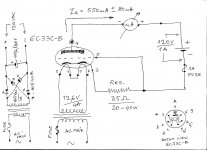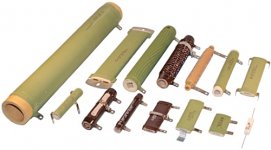Hi albertli !
To check 6c33c-b tube condition you need :
1) filament transformer with 6,3 VAC / 8A or 12,6VAC / 4A secondary .
2) regulated or non regulated DC source with 120V which is capable to deliver at least 1A of constant current .
3) one wire wound power resistor 35 ohm / 25 - 50W .
4) quality tube socket and pre cleaned tube pins.
test procedure is simple :
- First power on Transformer for filament supply.
- wait 5 min or even longer to heat up the tube cathodes .
- Than power on 120VDC source and read anode current .
- Reading must be nominal 550mA ,
with allowed factory variation of Plus or Minus 80 mA for each good tube , and that`s practically mean reading of Ia= 630mA Max. , or Ia=470mA Min ,
Any reading in between of this two Min/Max values mean that 6c33c-b tube is OK .
- Reading of anode current have to Not cross time more of 10 second !!!
Best Regards !
To check 6c33c-b tube condition you need :
1) filament transformer with 6,3 VAC / 8A or 12,6VAC / 4A secondary .
2) regulated or non regulated DC source with 120V which is capable to deliver at least 1A of constant current .
3) one wire wound power resistor 35 ohm / 25 - 50W .
4) quality tube socket and pre cleaned tube pins.
test procedure is simple :
- First power on Transformer for filament supply.
- wait 5 min or even longer to heat up the tube cathodes .
- Than power on 120VDC source and read anode current .
- Reading must be nominal 550mA ,
with allowed factory variation of Plus or Minus 80 mA for each good tube , and that`s practically mean reading of Ia= 630mA Max. , or Ia=470mA Min ,
Any reading in between of this two Min/Max values mean that 6c33c-b tube is OK .
- Reading of anode current have to Not cross time more of 10 second !!!
Best Regards !
Attachments
I run my 6C33C at 200V,
Mixed bias.<<You can do this and make use of your low bias voltage!
OTL, and I ran just heaters no HT for 24 Hrs before power up.
I run on one or two heaters in OTL.
And I also found some coating on the tube pins and cleaned with fine emery cloth only a couple of twists. Not file them down.🙂
Probably a good idea to check with a meter on ohms for shorts between the grid/anode/cathode. (Just to be safe before power up)
Regards
M. Gregg
Mixed bias.<<You can do this and make use of your low bias voltage!
OTL, and I ran just heaters no HT for 24 Hrs before power up.
I run on one or two heaters in OTL.
And I also found some coating on the tube pins and cleaned with fine emery cloth only a couple of twists. Not file them down.🙂
Probably a good idea to check with a meter on ohms for shorts between the grid/anode/cathode. (Just to be safe before power up)
Regards
M. Gregg
Last edited:
Great post. Thanks for sharing, much appreciated!Hi albertli !
To check 6c33c-b tube condition you need :
1) filament transformer with 6,3 VAC / 8A or 12,6VAC / 4A secondary .
2) regulated or non regulated DC source with 120V which is capable to deliver at least 1A of constant current .
3) one wire wound power resistor 35 ohm / 25 - 50W .
4) quality tube socket and pre cleaned tube pins.
test procedure is simple :
- First power on Transformer for filament supply.
- wait 5 min or even longer to heat up the tube cathodes .
- Than power on 120VDC source and read anode current .
- Reading must be nominal 550mA ,
with allowed factory variation of Plus or Minus 80 mA for each good tube , and that`s practically mean reading of Ia= 630mA Max. , or Ia=470mA Min ,
Any reading in between of this two Min/Max values mean that 6c33c-b tube is OK .
- Reading of anode current have to Not cross time more of 10 second !!!
Best Regards !
Sorry my ignorance in electronics, but what would be the one wire wound
in item 3 ??
3) one wire wound power resistor 35 ohm / 25 - 50W .
Thanks
Last edited:
Hi FullRangeMan !
Wirewound resistor mean relative big power resistor which is made in the way that some resistive wire is wound around some ceramic body , and usually can stand relative higher power disipation .
Here is the picture with some typical examples , but wirewound resistors exist in many other physical forms too .
Best Regards !
Wirewound resistor mean relative big power resistor which is made in the way that some resistive wire is wound around some ceramic body , and usually can stand relative higher power disipation .
Here is the picture with some typical examples , but wirewound resistors exist in many other physical forms too .
Best Regards !
Attachments
Wow! they are big ones.Hi FullRangeMan !
Wirewound resistor mean relative big power resistor which is made in the way that some resistive wire is wound around some ceramic body , and usually can stand relative higher power disipation .
Here is the picture with some typical examples , but wirewound resistors exist in many other physical forms too .
Best Regards !
Thanks again you most kind.
I cant imagine would be this device.
Regards
6c33c warm up question
I usually warm up my 6c33c tubes by turning on only filament heaters (and bias ) for minimum 15 minutes before turning on B+. I find that the sound is best after playing modestly for another 10 mins.
Sometimes for convenience I turn on filaments and just leave them heating for an hour or more before firing up the b+ and listening to the amps.
Question - am I depleting tube life during the warm up period, or only while b+ is on?
I usually warm up my 6c33c tubes by turning on only filament heaters (and bias ) for minimum 15 minutes before turning on B+. I find that the sound is best after playing modestly for another 10 mins.
Sometimes for convenience I turn on filaments and just leave them heating for an hour or more before firing up the b+ and listening to the amps.
Question - am I depleting tube life during the warm up period, or only while b+ is on?
- Status
- Not open for further replies.
- Home
- Amplifiers
- Tubes / Valves
- Buying guideline for 6c33c

